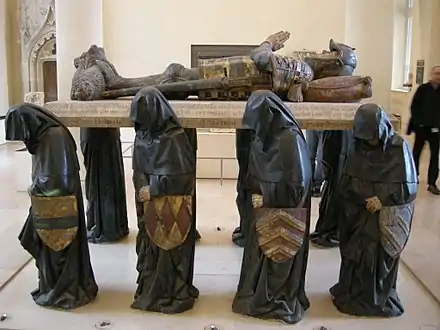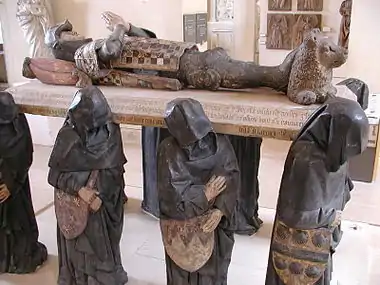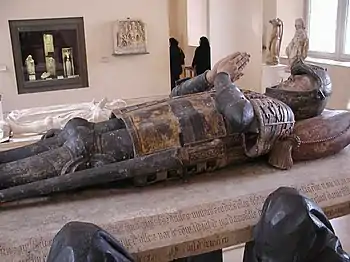Tomb of Philippe Pot
The Tomb of Philippe Pot is a 15th-century funerary monument commissioned by Philippe Pot (d. 1493), royal steward of Burgundy under Louis XI, between c. 1477 and 1480 for his burial at the chapel of Saint-Jean-Baptiste in Cîteaux Abbey, south of Dijon, France.[2] No definitive attributions have been made as to the artists and craftsmen who created the work, but Antoine Le Moiturier is often suggested to have produced the eight near life-sized mourners.

.jpg.webp)
The tomb has eight life-sized pleurants, represented as solemn and hooded pallbearers, each wearing a heavy black coat as they carry Philippe's recumbent effigy towards his grave.[3] Philippe is dressed in armor and a heraldic tunic, with his hands folded in prayer. The tomb is made of polychromed limestone, paint, gold and lead, it measures 181 (width) × 260 (height) × 167 (depth) cm.
The tomb was stolen during the French Revolution, and after changing a number of hands was positioned in private gardens in mansions in Dijon in the 19th century. It has been in the collection of the Musée du Louvre since 1899, where it is on permanent display.
Description
Philip the Bold (1363–1404) commissioned the first of the Burgundian tombs in the latter part of the 14th century. He hired the Dutch sculptor Claus Sluter, whose distinctive style in which many small pleurants are positioned surrounding the effigy was copied for the next century. Philippe Pot was Philip the Bold's godson, and royal steward and Grand Seneschal to the Dukes of Burgundy. He was raised at the Burgundian court, where he was educated. His tomb follows the tradition of the earliest ducal tombs; Sluter's influence is evident by the presence of pleurants.[3][4]

Philippe Pot reposes on a limestone plate or slab, and is dressed in a knightly helmet, tunic and armor with a gilded breastplate. His head rests on a cushion, his eyes are open and his hands are clasped in prayer. A sword lies to his side while a lion rests at his feet.[1] The eight mourners carrying his body are carved in black stone, and dressed in full-length black-hooded habits. Each bows their head in grief, and each bears an individually designed gilded heraldic shield, which may refer to Philippe's lineage, making the monument of the "Kinship tomb" type.[5] Their poise gives the impression of the slow movement of a funeral procession.[6]
The tomb is in good condition, but has been restored in places; a 19th-century engraving shows Philippe's hands broken apart.[7] The carvings on the edge of the slab are written in Gothic script and read CY DEMORRA MESSIR PHILIPPE POT [...] 7BRE AN MIL CCCCXCI [V].[8]
Although the monument is the last known tomb of the Burundian style,[1] it influenced later funerary artworks. The sculptor transformed the conventional size and placement of pleurants, which had been relatively small figures standing in niches around the sarcophagus. Its influence is evidenced by the similar tombs of Louis de Savoisy (d. 1515) and Jacques de Mâlain (d. 1527).[9]
Attribution

The monument was commissioned, perhaps by Philippe himself, to stand over his grave in the north arm of the chapel's transept. The artists and craftsmen involved in its production have not been identified, although the French sculptor Antoine Le Moiturier (active between 1482 and 1502) is often suggested as likely to have created the pleurants, given the similarity of the facial types to identified works of his, as well as, according to art historian Colum Hourihane, the "unusually rigid drapery".[8][10] Guillaume Chandelier has also been suggested as involved, but there is little supporting evidence.[11]
The tomb is in poor condition, covered by layers of brown dirt especially around the heraldry, as well as gloss and polyvinyl alcohol from an earlier cleaning. A major restoration, after period of nenewed research by the Restoration Center of the Museums of France in 2016–2017, begun in mid-2018.[12]

The 2018 to 2019 restoration, conducted in situ, is described by the museum as having "remove the bleaching of the surface layer, the lightening of the black layer and phenomena of gloss, the removal of brown fouling of the blazons, the cleaning of the bare stone areas. After a review of this first phase, given the results and additional observations, the second phase provides for the resumption of some closures, the elimination of old retouching, patching and retouching harmonization."[12][13]
Provenance
The tomb was seized by the state during the French Revolution, and sold in 1791 to the Duleu Society and Dardelin of Dijon.[8] It was acquired in 1808 by Charles Richard de Vesvrotte, lord of Ruffey-lès-Beaune, following a legal case against the state. De Vesvrotte placed the tomb in the garden of his hôtel particulier (mansion) in Dijon, the Hôtel Petit de Ruffey. He then temporarily moved it to a castle grounds in his possession, and then relocated to another of his mansion's gardens.[7]
It purchased by the comte Armand de Vesvrotte in 1886, and by the Louvre in 1899.[7]
References
Notes
- Jugie (2010), 52
- Sadler (2015), xi
- Sadler (2015), 22
- Hourihane (2012), 357
- McGee Morganstern (2000), p. 8
- Mayade, Stéphanie. "Tombeau de Philippe Pot – Musée du Louvre, Paris". Musardises en dépit du bon sens, 5 January 2011. Retrieved 24 May 2019
- Sterling & Salinger (1966), 158
- "Tomb of Philip Pot, Grand Seneschal of Burgundy". Portal of the collections of the Museums of France. Retrieved 8 December 2017
- Sadler (2015), 23
- Hourihane (2012), p. 40
- Hofstatter, 137, 256
- "Début de la restauration du tombeau de Philippe Pot". Louvre, 15 May 2018. Retrieved 14 April 2019
- Jugie, Sophie. Le Tombeau de Philippe Pot. Ediciones El Viso, 2019. ISBN 978-8-4948-2447-0
Sources
- De Winter, Patrick M. "Art from the Duchy of Burgundy". The Bulletin of the Cleveland Museum of Art, vol. 74, no. 10, 1987. 406–449. JSTOR 25160010
- Hofstatter, Hans. Art of the MIddle Ages. Harry N. Abrams, 1968
- Hourihane, Colum. The Grove Encyclopedia of Medieval Art and Architecture, Volume 1. Oxford University Press, 2012. ISBN 978-0-1953-9536-5
- Jugie, Sophie. The Mourners: Tomb Sculpture from the Court of Burgundy . Paris: 1; First Edition, 2010. ISBN 978-0-3001-5517-4
- McGee Morganstern, Anne. Gothic Tombs of Kinship in France, the Low Countries, and England. Penn State Press, 2000
- Sadler, Donna. Stone, Flesh, Spirit: The Entombment of Christ in Late Medieval Burgundy. Brill, 2015. ISBN 978-9-0042-9314-4
- Sterling, Charles; Salinger, Margaretta. French Paintings: A Catalogue of the Collection of The Metropolitan Museum of Art. New York: Metropolitan Museum of Art, 1966
External links
| Wikimedia Commons has media related to Tomb of Philippe Pot. |